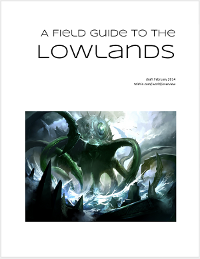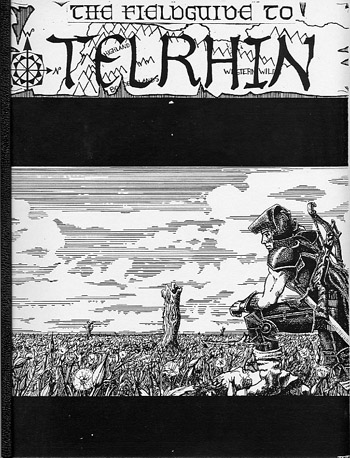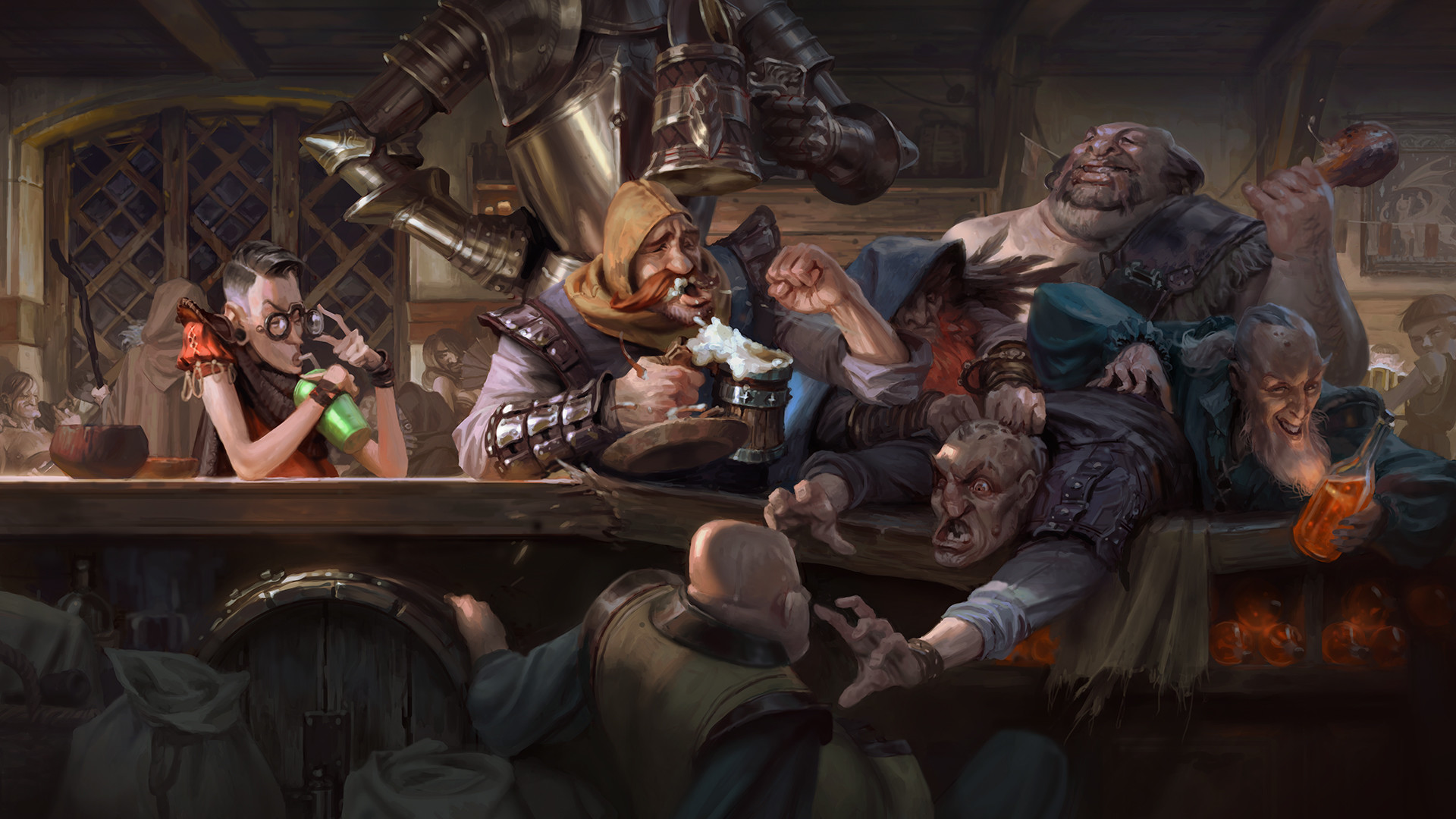The Overarching Story
On the surface Telrhin is a sandbox to play around in. Rob tombs, fight orcs, slay dragons. Although the SF Campaign began with a connection to higher forces and a fallen god, most of the campaigns open with first level characters of little consequence. But as the levels increase, the world opens up: fight for the old alliance against the powers of Her Dark Majesty, dethrone tyrants for personal gain, command the pirate leagues of the Valek.
As you gain power you get pulled into more than just politics and the chess games of queens and kings: the Tapestry and the Ilrajir, the forces of fate and destiny. The forgotten places of the Second World, and the spirits realms of Atavis, and the dreamlands of Oneiros. Because underneath it all is the story of Telrhin and the Twelve Dreams that shaped the present.
And that present, the Midſummer, is caught between the Ebb of Dreams and the Edge of Waking: the Ascendancy takes Telrhin across the Edge to a world of reason where magic is a forgotten myth. The Course of Dreams pulls back into the Ebb towards the Well and returns the world to magic and imagination.
Does the Waking sever the connection between the Three Worlds, sending the Ember and the Umbra tumbling back towards the Well of Dreams? Do they vanish in the haze of a childhood memory? And is this, ultimately, the vengeful dream of Her Dark Majesty, to see the world that wronged her die at the end of all things?
The world is waking. Will Serpent Earth cast the world back into dreams, or bring it bewildered and newborn across the Edge of Waking?
The world cracks, it heaves, it writhes, and from those places come ancient wonders, ancient nightmares, and the secrets of it all.
Scattered across Telrhin are pieces of all this, secrets and lost keys, items of power that themselves were part of the Ignis that started it all. And over and over the cycles repeat: Hael and Syr fighting in the Womb; Serpent Earth strangling the World Tree; Septar Fighting Thar-Emykl on the Plains of Pallos; Tar Kinathen battling Tyrsinel; the Two Queens Talonasi and Marbialla, last remnant of gods on earth. All echoes of the Dichotomy, re-incarnations of an overlapping myth.
Unravel the mysteries, unfold the Ilrajir, find the Ignis Stones, and set foot in the Court of the Tethered Duchess. Do this and you unearth the fading embers of the Great Dream. Do this and you rule the fates of the Three Worlds.
Panache, that's what a world needs
Adventure, sorcery, culture, mystery, a vibrant world with a rich history and a lot of color. And a good codpiece.
Which brings me to the point: a world setting is a framework, it needs to be cohesive and make sense, but most of all it needs to suit the story and the players. It needs to be amenable to the twists, turns, creativity and occasional bouts of the ridiculous.
Because it's just a fantasy game world. Religions are founded on less. You can't take it too seriously. Underneath it's still magic, swords, and orcs. And did I mention a good codpiece?
When it all comes together a game world should be more than the sum of its pieces: it should be vibrant, intriguing and have a sense of mystery. It should reward you for looking into the dark corners. And it needs to flex and stretch to fit the story you want to tell. So jump in, kick the wheels on the cart, ask what's on tap. Explore and make it yours. In the end, it's just a set for your adventures.
Indago (Latin /inˈdaː.ɡoː/; Gender: feminine; Type: verb, noun): "explore, investigate, hunt for" -- also "ring of huntsmen/nets/troops/forts; encircling with snares;"
Midſummer of a World

There was chaos in the melding of the Lost Dreams, giving way to the Great Dream: a gathered single world of mythic and impossible things. It cracked and boiled out into new parts: the Embers of lost secrets, the Umbra of ideas too large, and what remained was the Known World, the monde vrai.
Over the centuries this remnant world was slowly tamed under the boots of the Morden, the Kaladri, the Boradun, and the Grend: empires of fire, knowledge and steel. Looking back only to see legends and fairie tales.
And now the midſummer: the look beyond, the fears of change, the lost hopes of the past. But most of all, the foundations of it all cracking under the lies of a painted history. Will the world boil over again, thrown into more pieces, or will it solidify into the truths of the future, empires falling and dark ages replaced by new eras of golden summer?
But above all, the future will be determined by the slowly settling truths of an exhausted dream.
"It glistened as it opened, drops of glass and silver dripping down the twisting petals, a growing torrent showering the darkness with its first light. The world was born. The Great Dream began. And with it all the hope, all the tears, and all the long years to come in a struggle that would outlast the Dream, the Myth, and the Ages."
from "Chorus of the Embrings" a romanticized description of the birth of the Great Dream following the Diegesic Struggle, which was actually preceded by the Twelve Dreams. But people like to think of the Great Dream as the beginning.
A Pile of Broken Truths

The Old Field Guide
Telrhin is an FRPG setting with origins as far back as 1981. I've used it for almost every fantasy game I've run, from full blown campaigns on both coasts to one-shots in coffee shops. And a few games in France too. In the late Eighties a snippet from one of our games was aired on Swedish radio about the 'D&D phenomenon'. Jody Stephens from Big Star [wiki], Tommy Hoehn [wiki], and Lesa Aldridge from The Klitz even played in some games. And to the bride's undoubted chagrin, Telrhin has even been mentioned in a wedding toast.
What started as the clumsy imaginings of Tolkein-obsessed teenagers evolved into what it is now: an elaborately imagined world of high fantasy forty years deep.
The Tale of the Ember Queens
The Two Queens, first among the Ethrings and last vessels of the Ignis. They remain as strands of an ancient truth, a long thread of purpose in the tapestry of the world: shaped by the unfolding of years, the choices of men and the dreams of the Embrings as they slide into forgetfulness.
Their unfinished tale holds the secrets of the world.
Now, in the midsummer of the world, some of these scattered pieces gather in one place every year. This is the Court of the Tethered Duchess, a mystical event in the forests of the Lowlands, a rare court of the faie, where the Known World and the Embers meet. The few who see it may not know it, but in this moment the gathered threads of the story come together -- if briefly -- in this one glimpse of the grand tale. The Tale of the Two Queens.
This is a story of ambition, betrayal, jilted love and a tenuous hope. And it's the central core of the re-imagined world. The great satisfaction of a long campaign is the unraveling of the world's mysteries, all of which hinge on this story in one way or another. A story about the dark secret of the Kaladri, vestiges of a lost dream, a struggle to shape reality itself, and the consequence of broken hearts.
Telrhin Mk.IVb
Telrhin has had several incarnations. It began as a puerile Tolkein rip-off (mark i). It got a re-write and became a grognard Tolkein/Howard rip-off (mark ii). It got a facelift and evolved into a more sophisticated fantasy world with less grognard and more story (mark iii). Re-imagined from the ground up ("from the nave to the chaps"), Telrhin Mk.IV is a high fantasy world of crumbling empires, lost truths, secret alliances and a far reaching struggle to shape the future. A good place for 'a spot of adventuring'.
[ check out this post on re-working the origin story ]
Telrhin has been home to a handful of long and engaged campaigns, notably Campaign Theta and the SF Campaign. More recently all the work, artistry and long years of craftsmanship served as fodder for the Brothers Rahman in our anti-hero campaign best described as a satirical assault on heroic adventure gaming.
Currently we're running the Hill East Campaign, set in the Weatherpeaks as the party unravels the mysteries of the Tomb of Whispers, the cults of the moons, and hints of the Golden Queen.
Serpent Earth and the Edge of Waking
The primal story of the world origin is buried in the dreams of the Twins: intertwined beings who conceived the world and brought it into existence. It started with the Twelve Dreams (and the Lost Dream). As these overlapping worlds drifted away from the Well of Dreams they merged into a single world called the Great Dream.
The mythology of this is captured in the imagery of Serpent Earth -- the core of all things -- with the different worlds as coils in her long and possibly endless tail. This new world, that had gathered the contradictions and impossibilities of the twelve worlds together, fractured as it too continued the drift from the Well towards the Edge of Waking. Some of the more fantastical and inexplicable elements broke off, Serpent Earth shedding them into the Umbra (the place for spirits and god-like creatures) and the Ember (a place for the forgotten pieces of the mythic world).
Now, in the midsummer of it all, the world drifts closer to the Edge: will it cross into the reasoned and rational world of Waking, or will it fall back towards the Well and the endless possibilities of the imagination?
Buried in this site is a summary of the campaigns, a few archived issues of the Adventure Log (with some of the unpublished work from Issue 41), a Field Guide to the Lowlands, and of course the Encyclopaedia Telrhinica.
The Encyclopaedia is a database drawing from game notes, world elements and player notes. It started as WordPerfect files: a Bilbo-like digital clutterwork hiding the secrets of a world. There are over a thousand entries.
The Nine Hells of Home Brew
Telrhin has suffered through a variety of rules. Mostly AD&D variants, with a few forays into something more original (the George rules, and the high-school era ShadowRealms).
More recently it's been the 7th Edition of our OSR-inspired Stabmaster, with some tinkering on the side with the story-focused Fat Dragon rules.
And since you can't escape the ubiquitous DnD 5e, we've cobbled together a Telrhin version we're calling Stabdragon.
Rules: A Necessary Evil
A good roleplaying game is about the characters and their story. Rules help shape the reality and lend a certain flavor, but if anything a good game is good despite the rules.
Beyond the comfort of familiarity, rules are just rules, and if you're married to them you're probably not an actual roleplayer. Admittedly, if you have a bad narrator/gamemaster who isn't collaborating and wants to control everything, the rules can be a form of 'player bill of rights', enshrining the capabilities and options the player has in a game. But better yet, quit and find someone more creative to run your game.
Of course some players play for the rules, approaching a roleplaying game as a tactical strategy game with rules as a tool to manipulate to their advantage. Though I've enjoyed many a good discussion/argument over a rule while a game is in progress, these people usually suck as roleplayers and might be served in games with boards and minis.
If the story is good and the world is rich, all a player really needs to know is that every time they stab someone the same thing happens.
Where is it All?
The full site is only open to players (old and new!). DM me if you think that's you. Even the menu is truncated until then.
You can check the main blog for a few posts on the world though:
The Court of Kalidahr Irongrip (courts, politics and the 'day courts' of the faie)
The Gods Want You to Die (on the nature of the gods)
The Pox Crain (where things are more than they seem)
The World: A Bedtime Story (an origin tale)
Normal Folks in a World of Monsters (a long winded look at how a world works)
Ravines and Other Wilderness Killers (campaign mishaps)
What's Fashion if not a Codpiece (panache in a gaming world)
And some esoteric stuff on the origin tale: Revisiting the Origin Story (musings on world design)

